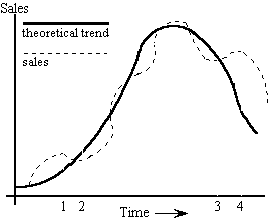What Is the Product Life Cycle?
The product life cycle is a concept widely used in marketing and business, which illustrates the stages a product goes through from its inception to its decline and eventual withdrawal from the market.
By understanding these stages, businesses can better manage their products and make informed decisions on marketing strategies, pricing and even product development.
In this article, we will explore the four product life cycle stages, the factors that influence the length of each stage, and the advantages of using the product life cycle in managing your products.
Overview of the Product Life Cycle Stages
There are four stages in a product’s life cycle:
- Introduction
- Growth
- Maturity
- Decline

Each stage has its own characteristics and challenges, and understanding these stages can help businesses optimize their marketing efforts, maintain a competitive edge, and extend the life of their products.
-
Introduction Stage
The introduction stage marks the debut of a product in the market. During this phase, businesses often face high costs associated with product development, research, and marketing. Sales are typically slow as the product is new and demand is yet to be established. The primary objective during this stage is to create awareness about the product and its benefits.
Creating a Market Strategy
A crucial part of the introduction stage is developing a market strategy that involves investing in advertising and marketing to make consumers aware of the product and its benefits. This stage can take time to progress, depending on the complexity of the product, its level of innovation, how well it meets customer needs, and the presence of competition in the marketplace.
Price Skimming vs. Price Penetration
During the introduction stage, businesses have two main pricing options: price skimming and price penetration. Price skimming involves setting a high initial price and then lowering it to ‘skim’ different consumer groups as the market grows. On the other hand, price penetration means setting a low price to reach as much of the market as quickly as possible before increasing the price once the product is established.
-
Growth Stage
If a product successfully moves past the introduction stage, it enters the growth stage of the product life cycle. This phase is characterized by a rapid increase in sales and profits as demand grows. Businesses should focus on increasing their product’s market share and improving distribution channels during this stage.
Competition and Branding
As the product gains traction, competitors may enter the market with their own versions or improvements. This makes branding and product differentiation increasingly important to maintain a strong position in the marketplace. Businesses should also closely monitor pricing and product availability to continue driving sales in the face of growing competition.
-
Maturity Stage
The maturity stage is often the longest phase in the product life cycle. At this point, the product is well-established in the market, and sales growth begins to slow down. Competition becomes more intense, and the focus shifts towards maintaining market share and maximizing profitability.
Marketing and Product Differentiation
During the maturity stage, marketing and product differentiation become critical factors in maintaining market share. Businesses may need to invest in promotional activities, enhance product features, or adjust pricing to stay ahead of competitors. It’s also essential to keep an eye on emerging trends and consumer preferences to avoid being left behind.
-
Decline Stage
The decline stage is the final phase in the product life cycle when sales and profits start to decrease. This can be due to market saturation, new innovations, or changing consumer preferences. While it may be tempting to abandon the product altogether, businesses can explore strategies such as introducing new versions, modifying distribution channels, or reducing prices to inject new life into the product.
Using the Product Life Cycle
Understanding the product life cycle stages and their characteristics can help businesses make informed decisions regarding their products.
Advantages of Using the Product Life Cycle
- Strategic Decision-Making: By recognizing the current stage of a product, businesses can choose the most appropriate strategies for marketing, pricing, and product development.
- Resource Allocation: Knowing the life cycle stage of a product helps businesses allocate resources more effectively, focusing on products with the most potential for growth and profitability.
- Product Portfolio Management: The product life cycle can help businesses manage their product portfolio by identifying products that need to be phased out, updated, or replaced with newer innovations.
- Extending Product Life: By understanding the life cycle stages, businesses can implement strategies to extend the life of their products, thus maximizing profitability and market presence.
Successful Examples of Product Life Cycle Management
Below are some well-known examples of products that have navigated or are navigating the product life cycle effectively:
- Apple iPhone: Apple has been able to maintain the iPhone at the mature stage for an extended period by regularly releasing updates, redesigns, and renewed marketing efforts to keep the product relevant and appealing to consumers.
- Netflix: Once a DVD rental delivery service, Netflix successfully pivoted to a subscription streaming model in response to changing market demands, extending its product life cycle and staying ahead of competitors.
- Electric Vehicles: Electric vehicles are currently in the growth stage of their product life cycle, with continuous innovation and improving sales potential as more companies invest in this market.
By understanding the product life cycle and its stages, businesses can make informed decisions regarding their products and strategies, ultimately leading to better management, increased profitability, and sustained market presence. Implementing the product life cycle concept in your business can help you stay ahead of the competition, adapt to changing market conditions, and maximize returns on your product investments.